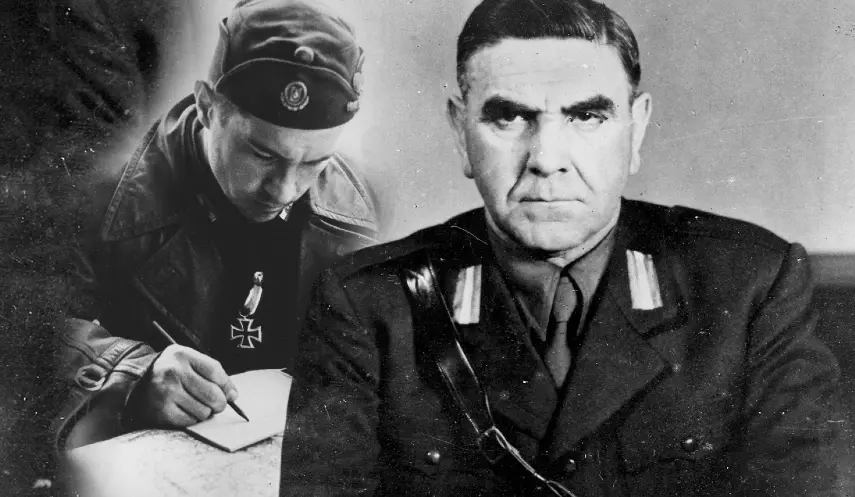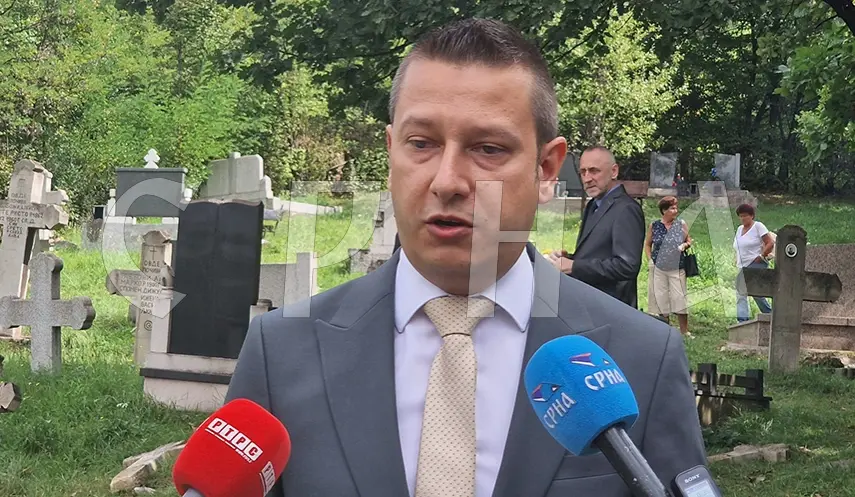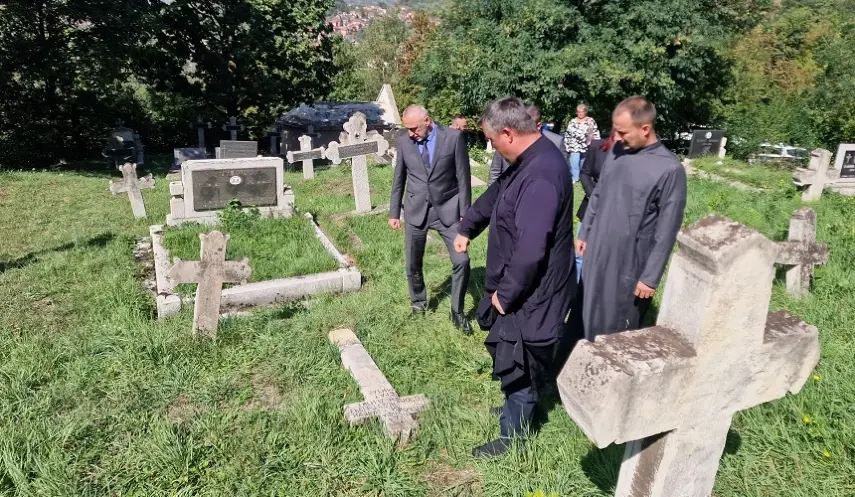FORMATION OF THE JASENOVAC CONCENTRATION CAMP, THE ROLE OF MAKS LUBURIĆ
Region - Serbs - crimes /3/
04/24/2025
10:00

BANJA LUKA, APRIL 24 /SRNA/ - The takeover of the administration of the so-called second occupation zone from fascist Italy in the summer of 1941 necessitated the relocation of the then main concentration camp headquartered in Gospić to a new location.
The Ustasha "defense," or rather the Office of the 3rd Ustasha Supervisory Service, headed by Vjekoslav Maks Luburić, who had control over all camps in the Independent State of Croatia /NDH/, decided that the location of the future camp would be in the Lonjsko Polje area.
There were few reasonst for that. The proximity of the rivers Sava and Strug turned out to be ideal for the plan to establish a new camp. On the one hand, this made escapes from the camp impossible, as well as any possible attempts to attack it.
In addition, this area was located at the junction of several regions /Potkozarje, Banija and Western Slavonia/ in which the Serbian population made up a significant share. This enabled the Ustashas to quickly and easily bring the population from the aforementioned areas, and deportations could be carried out on foot, by trucks or with the help of horse-drawn carts, according to the book "Forgotten - A Book about the Last Jasenovac Camp Inmates," authored by Dejan Motl and Đorđe Mihovilović, excerpts of which are published by the srpskanational.com portal.
To this should be added the railway connection of the area with almost all parts of NDH, as the Zagreb-Belgrade railway line passed through the future headquarters of the new camp. It is estimated that the first prisoners were transported to the Jasenovac railway station between August 19 and 21, 1941, marking the beginning of the existence of the Jasenovac concentration camp.
The Jasenovac concentration camp had its own genesis. It was first located outside the settlement of Jasenovac, at the locations of Krapje and Bročice, which were several kilometers away from Jasenovac. These were Camps I and II in the Jasenovac Concentration Camp system, which were located along the very right bank of the Strug River.
Due to the heavy autumn floods, both camps were closed in mid-November 1941, and a new one, Camp Three, was established at the entrance to the town of Jasenovac itself. These were the industrial facilities of the Bačić family from Jasenovac, dominated by the brick production plant /after which the camp would later be named the "Ciglana" i.e. the "Bricklayers' Camp"/. The Ustasha authorities confiscated all of the Bačić family's property, as a Serbian family, and placed it under the management and supervision of the "Ustasha Defense".
It is believed that this camp began operating between November 14 and 16, 1941. It was the largest and most notorious Jasenovac camp, operating continuously until April 22, 1945.
The Gospić group of camps /Gospić, Jadovno, Slana and Metajna, with the associated execution sites on Velebit/ operated until mid-August 1941. The Ustasas had to abandon these camps because the armed forces of the NDH were unable to successfully counter the increasing activity of the insurgents, who had been actively fighting since the summer of 1941.
Therefore, the Italian government decided that its army would occupy the belt extending south of the line Vinica - Plitvice Lakes - Plješevica - Mount Šator - Velika Golija - Prenj - Troglav, thus placing these camps under Italian military administration.
Even after the establishment of Camp III, the Jasenovac Concentration Camp continued to expand. Its formation continued throughout 1942, when the camp units – Kožara and Stara Gradiška – were established, as well as the camps in Dubički Krečani near Hrvatska Dubica and Uštica, a village located on the right bank of the Sava River, opposite Jasenovac. In addition to these camps, several camp farms were also formed.
These were mainly villages between Jasenovac and Stara Gradiška, which were inhabited by Serbs. The villagers were mostly deported to camps, while camp inmates were brought to the empty yards and estates to do seasonal agricultural work. After the work was completed, the prisoners were most often killed there.
Such camp economies existed in the villages of Mlaka, Jablanac, Gređani /the so-called Vojnovića Salaš/, Bistrica and Draksenić. In addition to camp units and camp economies, the Jasenovac concentration camp also consisted of numerous execution sites where mass liquidations of prisoners were carried out. The largest was located near the village of Donja Gradina, on the right bank of the Sava River, opposite the location of Camp III.
Camp III stretched along the left bank of the Sava River, covering an area of about 1.5 square kilometers. It was initially surrounded by a double row of barbed wire, and from mid-1942 by a high wall. The wall surrounded the camp from the west, north, and east, while the Sava River served as a natural barrier to the south. The walls were equipped with watchtowers, from which it was easy to control the camp and the camp's surroundings.
The camp inmates without any professional qualifications for the existing trades in the camp faced the most difficult situation. They did the hardest work and often died of exhaustion and hunger or were liquidated upon the arrival of new prisoners.
Any inmate who was not assigned to a work group within a short period of time was taken to Donja Gradina and killed there. The total number of inmates in the camp was 3,000 to 4,000, although this number was sometimes much higher when necessary.
At the beginning of April 1945, Luburić arrived at the camp with a transport of about 400 people from Sarajevo. They were imprisoned in a separate barracks and had no contact with the other prisoners. After a few days, they were all taken to Gradina and killed. In the spring of 1945, the last prisoners from Lepoglava were brought to Jasenovac, imprisoned in ten cattle cars. They did not even enter the camp, but were immediately transported by ferry across the Sava and liquidated.
In early 1945, the camp was frequently overflying by Allied aircraft flying towards Hungary. These flights boosted the morale of the camp inmates, but what they expected and hoped for did not happen, which was that these aircraft would bomb the camp and the camp wall, thus opening a way for them to escape.
From April 6 to 20, 1945, the Ustashas began an operation to cover up traces of the crimes committed in the concentration camp. The Ustashas formed working groups from among the camp inmates, with the task of searching for and excavating previous graves in Donja Gradina, from which they then removed and burned the remains of the Jasenovac victims.
The ashes of the burned corpses were usually thrown into the Sava River or buried in the ground. Every day a new group of inmates went to Gradina because the previous group was killed the day before. The removal of people and materials lasted until April 20, and during that time four large fires could be seen from Gradina, burning continuously day and night. Everyone in the camp knew that the Ustashas were liquidating the camp and that they would not leave any witnesses of their crime alive.
According to the testimony of the surviving prisoner Jovan Živković, on the evening of April 20, Ustasha sergeant major Lisac called the group members and informed them that the camp had to be moved to Sunja and that a train with eight wagons was ready for the first group of 400 camp inmates to be moved. The train had not even left Jasenovac, and that evening screams and moans could be heard, so that it became clear to those camp inmates who remained in the camp that the Ustashas had killed that group of 400 camp inmates.
On April 21, 1945, in the afternoon, the camp inmates were ordered to take all their belongings because they had to move to the tailoring and shoemaking workshop building, which was located in the southeastern part of the camp. It was a large building with a ground floor, a first floor, and an attic. Some camp inmates could not stand the tension that prevailed and ended their torment by hanging themselves in the living quarters or workshops.






